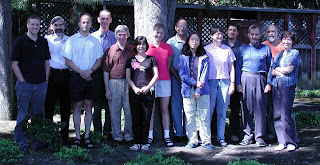Abel Prize to NYU Professor S.R. Srinivasa Varadhan
 The Norwegian Academy of Sciences has awarded the Abel Prize for Mathematics to the Indian-American professor Sathamangalam R. Srinivasa Varadhan (67) of New York University. Varadhan receives the prize “for his fundamental contributions to probability theory and in particular for creating a unified theory of large deviation”.
The Norwegian Academy of Sciences has awarded the Abel Prize for Mathematics to the Indian-American professor Sathamangalam R. Srinivasa Varadhan (67) of New York University. Varadhan receives the prize “for his fundamental contributions to probability theory and in particular for creating a unified theory of large deviation”.The Abel prize, worth six million kronor (864,450 dollars), was created by Norway's government in 2002 to mark the 200th anniversary of the birth of the great Norwegian mathematician Niels Henrik Abel. It is viewed as the equivalent of a Nobel prize, which is not awarded for mathematics.
Varadhan hails from Chennai, India. He received his undergraduate degree in 1959 from Presidency College, Chennai (then Madras) and his doctorate in 1963 from the Indian Statistical Institute, Kolkata (then Calcutta). Since 1963, he has worked at the Courant Institute of Mathematical Sciences, New York University, where he is currently Professor of Mathematics and Frank J. Gould Professor of Science.
Probability theory is the mathematical tool for analyzing situations governed by chance. Varadhan's speciality lies in the theory of large deviations or studies of the occurrence of rare events. Over the last four decades, the theory of large deviations has become a cornerstone of modern probability, both pure and applied. Varadhan’s theory of large deviations provides a unifying and efficient method for clarifying a rich variety of phenomena arising in complex stochastic systems, in fields as diverse as quantum field theory, statistical physics, population dynamics, econometrics and finance, and traffic engineering. It has also greatly expanded our ability to use computers to simulate and analyze the occurrence of rare events as is described by the Abel Committee,"Varadhan’s work has great conceptual strength and ageless beauty. His ideas have been hugely influential and will continue to stimulate further research for a long time”.
This marks the second time in three years an NYU mathematician has won the Abel Prize. In 2005, it was given to Professor Peter Lax of the Courant Institute. That's an occurrence of a rare event indeed!
We did not wish to end this posting on a sad note but Mathematicians are also human and unfortunately some of them had to face and survive greatest tragedies in life and then continue their great work. In order to put Prof. Varadhan's achievement in a greater perspective of life that goes beyond Mathematics or any award whatsoever, we thought we should mention to our readers that the elder of Varadhan's two sons, Gopal, was killed in the attacks on the World Trade Center on September 11, 2001.




